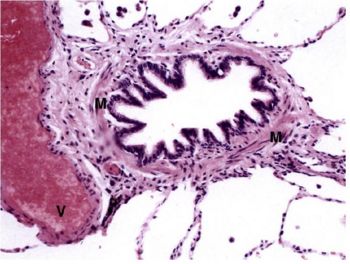Bronchi and Bronchioles - Anatomy & Physiology
Jump to navigation
Jump to search
|
|
File:Routeofairthroughrespiratorysystem.jpg
Schematic Diagram showing the route air takes through the respiratory system
Introduction
The trachea bifurcates at the levels of the 4th-6th intercostal space, approximatley halfway between the thoracic inlet and the diaphragm. dividing into two Principle 'Bronchi', tubes which conduct air into the lngs. These further divide into smaller bronchi and bronchioles. The initial division after entry to the lung is known as the Principle Bronchi, and this further divides into two Lobar Bronchi' for the left lung, and into four Lobar Bronchi for the right lung.
Structure
- The structure of the larger bronchi is identical to that of the trachea. On the smaller bronchi the C-shaped cartilage rings are gradually replaced by irregular plaques of cartilage. Bronchioles have no cartilage at all.
- The bronchioles are less than 1mm in diameter, and undergo further divisions, the last of which is characterised by the loss of goblet cells.
Function
- The bronchi and bronchioles are parts of the 'Conduction Zone' of the respiratory system - allowing the passage of air from the external environment into the lungs where gaseous exchange can take place.
- Some of the Bronchioles have alveoli scattered along their length, and thus form part of the 'Respiratory Zone' - a site for gaseous exchange.
Histology
- The histology of the Bronchi is almost identical to that of the trachea - the lumen of the bronchus is lined by a pseudostratified epithelium, including goblet cells and serous cells.
Beneath the narrow layer of connective tissue under the epithelium lie well-developed spiral bands of smooth muscle.
- The Bronchioles have no cartilage rings but have well developed muscular walls to enclose the lumen. The epithelium is reduced to cuboidal, and in the normal animal it contains no mucus secreting glands. There are many lymphoid nodules beneath the epithelial layer.
- Respiratory Bronchioles have few alveoli scattered along the length, at the entrance of which is simple squamous epithelium, and bronchial smooth muscle bundles.
Species Differences
- Between species the diameter of the bronchi and bronchioles vary greatly and more significantly than the variations of the trachea.
- The number of bronchial divisions before bronchioles are present varies by species - small mammals such as mice may have only 4/5 generations, whereas 12+ may be necessary in larger animals.
Links
Bronchi and Bronchioles - Pathology
References
- Dyce, K.M., Sack, W.O. and Wensing, C.J.G. (2002) Textbook of Veterinary Anatomy. 3rd ed. Philadelphia: Saunders.
- Budras, K.D., McCarthy, P.H., Fricke, W. and Richter, R. (2002) Anatomy of the Dog. 4th ed. Hannover: Schlutersche GmbH & Co. KG, Verlag und Druckerei.
